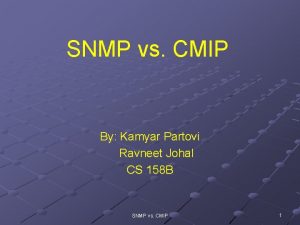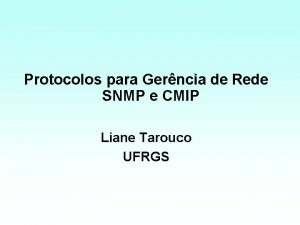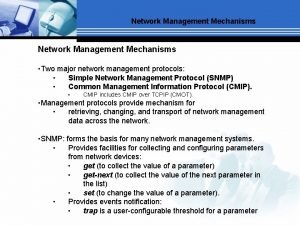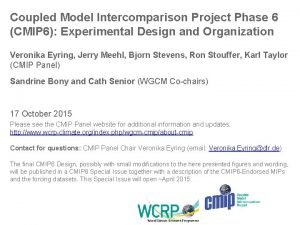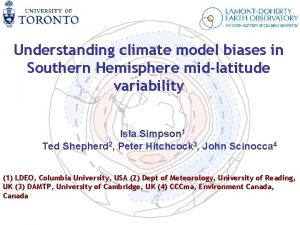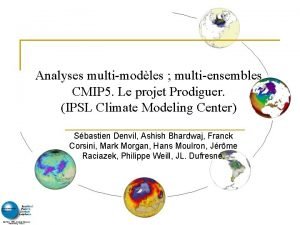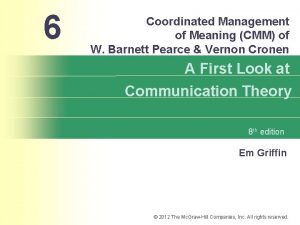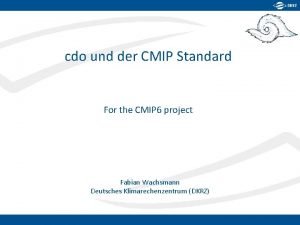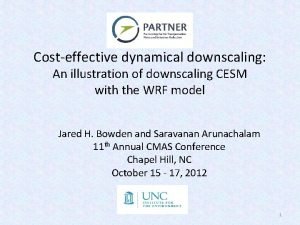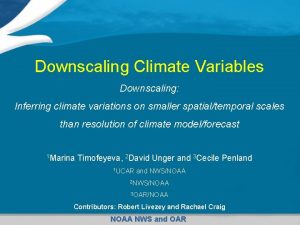Coordinated Regional Downscaling Experiment CMIP 6 Regional Information










- Slides: 10

Coordinated Regional Downscaling Experiment: CMIP 6 & Regional Information for IPCC CORDEX Scientific Vision: To advance and coordinate the science and application of regional climate downscaling through global partnerships Goals: Ø To better understand relevant regional/local climate phenomena, their variability and changes, through downscaling. Ø To evaluate and improve regional climate downscaling models and techniques Ø To produce coordinated sets of regional downscaled projections worldwide Ø To foster communication and knowledge exchange with users of regional climate information

CORDEX: A CMIP 6 Diagnostic MIP Primary CMIP 6 Question Addressed: How can we assess future climate changes given climate variability, predictability and uncertainties in scenarios? Primary WCRP Grand Challenges Addressed: 1. Regional climate information (though this GC is evolving) 2. Weather and climate extremes Potential Coordination: High. Res. MIP

CORDEX: A CMIP 6 Diagnostic MIP The GCMs are consistent with the observed large-scale climate statistics, while the RCM simulations produce greater consistency with the fine scale statistics.

CORDEX: A CMIP 6 Diagnostic MIP Connectivity to DECK: Analysis of downscaled CMIP DECK simulations (30 years) for the pre-industrial control compared to the transient forcing cases (e. g. , CMIP 6 Historical) will determine potential regional climate-change detection. Connectivity to CMIP 6 Historical and Scenario Simulations: 1. Analysis during the historical period (1950 -2014) will indicate where and when the downscaling provides regional detail of physical behavior that agrees better with observations than the driving GCM output and provides robust additional fine scale climate information. 2. Analysis during the historical period (1950 -2014, though ideally, 1900 -2014) from downscaling of multiple realizations by the same GCM will indicate the magnitude of regional unforced variability. When coupled with analysis of downscaled projections (2015 -2100), results will assess where and when the downscaling provides regional detail of physical behavior that exceeds noise levels of unforced internal variability.

CORDEX: A CMIP 6 Diagnostic MIP Targeted GCM simulations should: v cover as well as possible the range of GCM climate model sensitivity; v provide acceptable quality of historical climate simulations in the regions where they supply boundary conditions; v provide acceptable quality of historical climate simulations for important large-scale features affecting regional climates, such as ENSO, NAO, etc. ; v have a distinctive model development history. Ideal GCM output for downscaling: 1) Sufficient for dynamical and empirical statistical downscaling (transient climate-change simulation) 2) Multiple realizations of the same GCM for both the pre-industrial and transient climate-change simulations [explore unforced variability] 3) Pre-industrial control runs (CMIP DECK) and runs with changes in only one climate forcing (if part of CMIP 6) [explore regional detection and attribution]

CMIP 6 & CORDEX – Flagship Pilot Studies • • First FPS call closed 15 Feb. 2016 8 proposals (under review) from 6 CORDEX regions Coordinate developments in conv. -permitting climate sim. Must have u u u • • Fine-scale processes important to region’s climate (physical basis) Observational basis for verification (analysis basis) User applications (VIA basis) Potential connection with other WCRP programs, esp. GEWEX Details: www. cordex. org

CMIP 6 & CORDEX – CORE Simulations CORDEX Coordinated Output for Regional Evaluations (CORE) • In development • Motivated by IPCC Workshop on Reg. Climate (Sept. 2015) • Elements u u u u Succinct set of downscalings for each region Provide a core foundation for additional work by others Span plausible range of climate change => 3 distinct GCMs? CMIP 5? Historical + RCP 8. 5? 3 -4 RCMs? ESD methods? Resolution?

CORDEX: A CMIP 6 Diagnostic MIP Beyond the details, many broad questions to address: • • What are realistic expectations for input to the AR 6? Are contributions possible to IPCC special reports? What timeline(s) are needed? . . .

CORDEX in CMIP 6: Details - Preferred output period: 1951 -2100 for transient climate change (RCP 8. 5, RCP 4. 5 and RCP 2. 6 for 2015 -2100); 30 years of pre-industrial control. - For dynamical downscaling: 6 -hourly instantaneous surface pressure 6 -hourly instantaneous three-dimensional fields of temperature, atmospheric specific humidity, zonal wind and meridional wind - For statistical downscaling, also: maximum daily surface (2 m) temperature minimum daily surface (2 m) temperature daily surface temperature (2 m) daily surface dewpoint temperature (2 m) daily zonal wind (10 m) daily meridional wind (10 m) daily precipitation daily precipitable water monthly sea surface temperature

CORDEX in CMIP 6: Details - Supplementary variables that are desirable: daily soil moisture (vertically integrated) daily snow density daily snow albedo daily low and medium cloud cover 6 -hourly instantaneous geopotential height at 850, 700 and 500 h. Pa
